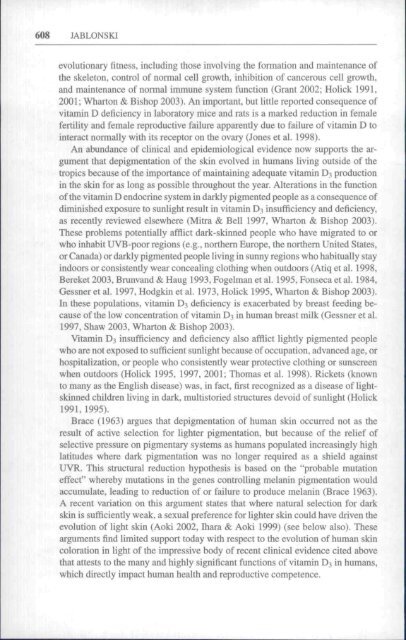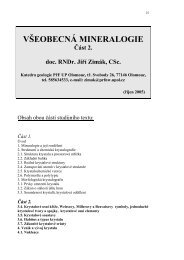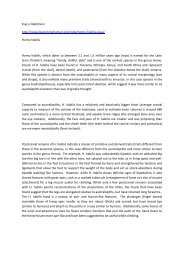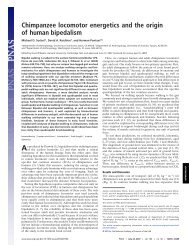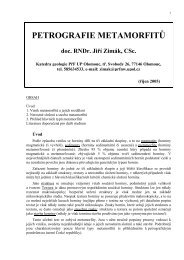THE EVOLUTION OF HUMAN SKIN AND SKIN COLOR Nina G ...
THE EVOLUTION OF HUMAN SKIN AND SKIN COLOR Nina G ...
THE EVOLUTION OF HUMAN SKIN AND SKIN COLOR Nina G ...
You also want an ePaper? Increase the reach of your titles
YUMPU automatically turns print PDFs into web optimized ePapers that Google loves.
608 JABLONSKIevolutionary fitness, including those involving the formation and maintenance ofthe skeleton, control of normal cell growth, inhibition of cancerous cell growth,and maintenance of normal immune system function (Grant 2002: Holick 1991,2001; Wharton & Bishop 2003). An important, but little reported consequence ofvitamin D deficiency in laboratory nuce and rats is a marked reduction in femalefertility and female reproductive failure apparently due to failure of vitamin D tointeract normally with its receptor on the ovary (Jones et al. 1998).An abundance of clinical and epidemiological evidence now supports the argumentthat depigmentation of the skin evolved in humans living outside of thetropics because of the importance of maintaining adequate vitamin Di productionin the skin for as long as possible throughout the year. Alterations in the functionof the vitamin D endocrine system in darkly pigmented people as a consequence ofdiminished exposure to sunlight result in vitamin D3 insufficiency and deficiency,as recently reviewed elsewhere (Mitra & Bell 1997, Wharton & Bishop 2003).These problems potentially afflict dark-skinned people who have migrated to orwho inhabit UVB-poor regions (e.g., northem Europe, the northem United States,or Canada) or darkly pigmented people living in sunny regions who habitually stayindoors or consistently wear concealing clothing when outdoors (Atiq et al. 1998,Bereket 2003, Brunvand & Haug 1993. Fogelman et al. 1995. Fonseca et al. 1984.Gessneret al. 1997, Hodgkin et ai. 1973, Holick 1995, Wharton & Bishop 2003).In these populations, vitamin D3 deficiency is exacerbated by breast feeding becauseof the low concentration of vitamin D? in human breast milk (Gessner et al.1997, Shaw 2003, Wharton & Bishop 2003).Vitamin Di insufficiency and deficiency also afflict lightly pigmented peoplewho are not exposed to sufficient sunlight because of occupation, advanced age, orhospitalization, or people who consistently wear protective clothing or sunscreenwhen outdoors (Holick 1995, 1997. 2001: Thomas et al. 1998). Rickets (knownto many as the English disease) was, in fact, first recognized as a disease of lightskinnedchildren living in dark, multistoried structures devoid of sunlight (Holick1991,1995).Brace (1963) argues that depigmentation of human skin occurred not as theresult of active selection for lighter pigmentation, but because of the relief ofselective pressure on pigmentary systems as humans populated increasingly highlatitudes where dark pigmentation was no longer required as a shield againstUVR. This structural reduction hypothesis is based on the "probable mutationeffect" whereby mutations in the genes controlling melanin pigmentation wouldaccumulate, leading to reduction of or failure to produce melanin (Brace 1963).A recent variation on this argument states that where natural selection for darkskin is sufficiently weak, a sexual preference for lighter skin could have driven theevolution of light skin (Aoki 2002, Ihara & Aoki 1999) (see below also). Thesearguments find limited support today with respect to the evolution of human skincoloration in light of the impressive body of recent clinical evidence cited abovethat attests to the many and highly significant functions of vitamin D3 in humans,which directly impact human health and reproductive competence.


